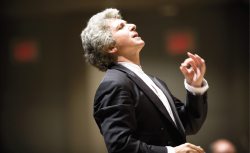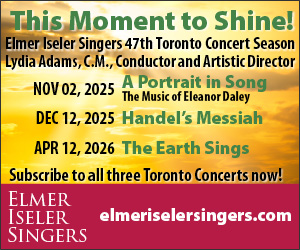Those of you who read me know I like to feign rage from time to time about certain concert behaviours that I think mess up the show for other patrons. Pet among my peeves over the years are: The Walking Ovationists, The Pre-Mature Ejaculators and the Deci-belligerent Shushers.
The Walking Ovationists are of course those who leap to their feet the instant the performance is over and then with varying degrees of subtlety start a sidelong sidle for the exits (toes of their row-mates be damned).
The Pre-Mature Ejaculators are the ones with such a desperate need to prove they knew the piece was over (and that it was great for them) by bellowing BRAVO! into the first micro-second of God-given silence that should be the true ending of any piece of music.
The Deci-belligerent Shushers are the self-appointed guardians of the classical concert-hall’s code of silence, hissing their hatred at even the minutest muttered transgression (while somehow failing to realize that their shushes rip the listening envelope to shreds more completely than any other utterance could).
Oh, I could go on and on and on! Swarming like jackals around these three are the Mid-Movement Crinkly Candy Unwrappers; the Why-The-Hell-Are-You-Here-If-You’re-That-Sick Coughers; the Balcony Texters, the Baleful Glarers … You get the picture.
But there is one group you have NEVER heard me rail at in these pages: namely the people who know so little about the “rules” of concert hall behaviour that they applaud in the wrong places.
And here is a story that illustrates perfectly why.
 It was a performance of the Toronto Symphony Orchestra back in the spring (early May), with an audience that seemed less well-trained in concert etiquette than usual, right from the start, and proved it a few times in the first half. Peter Oundjian was conducting, and the work after intermission was to be Tchaikovsky’s Symphony No.6 “The Pathétique.” At the start of the second half, as he is affably wont to do, the Maestro stepped forward, like any good Maitre D’, to chat for a moment with the guests in his house about what was on the menu.
It was a performance of the Toronto Symphony Orchestra back in the spring (early May), with an audience that seemed less well-trained in concert etiquette than usual, right from the start, and proved it a few times in the first half. Peter Oundjian was conducting, and the work after intermission was to be Tchaikovsky’s Symphony No.6 “The Pathétique.” At the start of the second half, as he is affably wont to do, the Maestro stepped forward, like any good Maitre D’, to chat for a moment with the guests in his house about what was on the menu.
I won’t try to replicate his words. But the gist of it went something like this: that this possibly greatest of all Tchaikovsky’s symphonies was typical in some way – four clearly defined separate movements – but that it was also atypical in some other interesting ways. Among them was that it didn’t follow the expected roadmap. Instead of the four movements following a pattern that goes fast, slower, fast-ish, fastest, Tchaikovsky’s Sixth hits its peak of fast and loud in the third movement – so much so that as an audience it’s impossible not to want to applaud.
“So in fact,” Oundjian said to the house guests, “if you feel like applauding at that point go right ahead, because that is what Tchaikovsky’s own audience would have done.”
This rule, he explained, of not applauding until the piece is over, didn’t really take hold until a decade after Tchaikovsky wrote this absolutely wonderful work. “In fact,” Oundjian said, “applaud whenever you feel like it – we won’t mind.”
What followed was completely memorable. There was a sprinkling of quiet applause after the first movement (and no one glared at anyone else). It was quiet-ish after the second. But after the third movement, even concertgoers who would normally have sat on their hands joined the general clapping. Somehow it was as if we all knew that as much as anything we were rooting for a composer trying with every fibre of his being to give us a happy ending that was never in the cards.
And after the terrible, wonderful final movement ... there was silence. A precious five to eight seconds of pure silence with a conductor literally and metaphorically holding the silence up there for us all to see and feel, in the palm of his upturned hand.
No one bellowed bravo; not one person leapt to their feet.
Until, precious silent seconds later, Oundjian lowered his hand and let the moment go. The audience rose to our feet to accord a special performance the concerted response it warranted for the universal feelings it had evoked.
So, Maestro, a belated BRAVO, for seizing that particular moment on that particular day, in that particular way.
So, what can be taken (usefully) away from this? Well, three things, I think.
First, presenters have an opportunity in welcoming new audiences, to decide anew for themselves what the do’s and don’ts of their particular house should be.
Second, these house rules should be cheerfully and confidently expressed at the outset of each and every event. (It is not enough to put asterisks in programs to indicate where silence is demanded.)
Third, conductors and performers have the power themselves to command the duration of the silences around and within the works they are performing, as actively as they command the notes of music between those silences.
So, what do you think? I would love to hear what you all, performers and presenters and audience members alike are doing, or want to say, about all this.
David Perlman can be reached at publisher@thewholenote.com.



